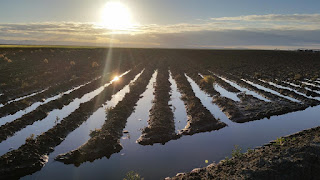Water is water. Right?
Well, there’s agua that comes from
sky and snow melt. Then there’s water that comes from wells and reservoirs
hundreds of miles away.
For years, Valley
farmers have grappled with the increase in soil salinity brought in by imported
water. That problem has been compounded during the severe drought as farmers
relied more on well water as an irrigation source.
 |
| Growers drilled more wells due to the severe drought. |
You
see well water contains high levels of salt and minerals. Over time, the salt
builds up in the soil and makes it hard and impermeable.Water has a tough time
getting down into the root system. Also, salt and minerals are tough on plants
and can clog irrigation systems, especially drip systems.
The salinity issue is
particular hard on almond trees, says UCCE Merced County almond expert David
Doll. Unlike crops like cotton and alfalfa, almonds can’t handle too much
salinity. The trees don’t have the plant structure to pump water into roots.
 |
| An aerial view of the salinity issue in the Valley. |
You might ask “Didn’t
the Valley experience a fairly normal rainy season?” And “didn’t rains help
ease salinity concerns for growers?”
Well, David warns growers
not to assume the rains leached out some of the salt from the soil.
“It’s
important to do some salinity sampling in your soil,” he tells us. “If you didn’t
do it in the fall, you should do it in the spring to understand where you are.
Keep the salinity component in mind. It may not be gone because of the rain. It
takes more than one year to clean up those kinds of problems,” David adds.
Remember, salinity can impact almond yields. The reason, he says, is trees wind up working
harder for water and that saps energy for crop growth and production.
 |
| The drought stressed many almond trees. |
UC experts say almond growers can apply gypsum to reduce sodium levels. It also improves the soil structure to help with leaching.Growers should consult with the certified crop advisers about using calcium-type amendments in the water.
Meanwhile in the fields, field scout Carlos Silva says more cotton plants have developed their first squares and pests counts are in check. But he notes he’s finding “lots of lygus” in nearby alfalfa fields. Fields harvested early this month are growing quickly in this warming weather and don’t be surprised to see growers cutting these fields sometime this week.
That means lygus bugs in these harvested fields will lose their habitat and look for a new home – most likely the young cotton fields. That could mean trouble for the developing cotton squares. Once again, Carlos reminds alfalfa growers to start leaving strips of uncut alfalfa to provide habitat for lygus.
Workshop
Alert: Don’t forget the free surface irrigation workshop scheduled for Friday,
June 3, from 9 a.m. to noon atthe UC Kearney Agricultural
Research and Extension Center, 9240 S. Riverbend Ave., Parlier. Learn about how to better conduct surface
irrigation activities, including furrow, border and irrigation systems. Speakers
include our friend Dan Munk, UCCE advisor in Fresno County; Daniele Zaccaria,
UCCE specialist at the UC Davis Department of Land, Air and Water Resources;
Eduardo Bautisa, of the USDA ARS Water Management and Conservation Research
unit in Arizona, and Khaled Balie, UCCE director in Imperial County. For more
information, contact Dan at (559) 241-7515 or email him at dsmunk@ucanr.edu













